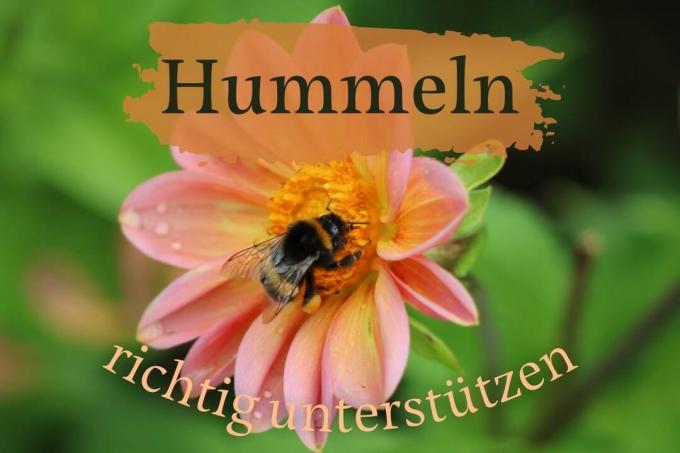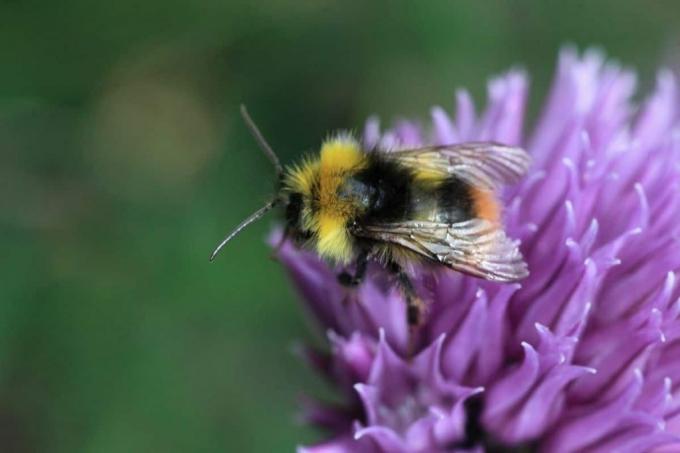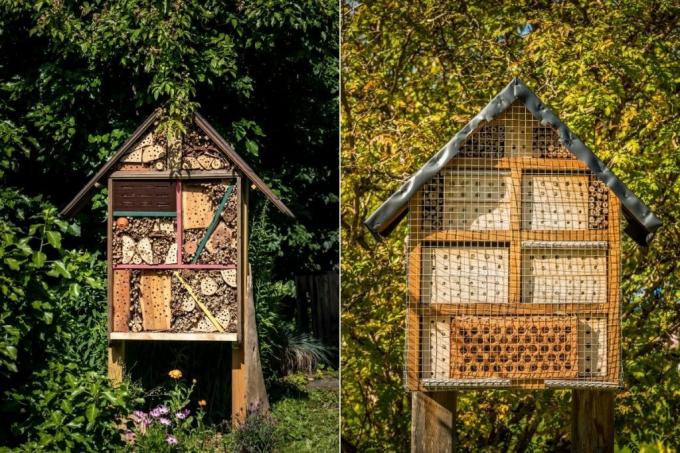
table of contents
- Popular & valuable in nature
- Bumblebees are dying
- Protect bumblebees
- Create nesting opportunities
- Support bumblebees with sugar solution
- frequently asked Questions
Every July, the same terrifying picture emerges when hundreds of dead bumblebees lie under linden trees. We have put together the causes of bumblebees dying and explain how you can support bumblebees in your own garden.
In a nutshell
- Bumblebees cannot find enough food in late summer
- need a lot of energy for their flight
- only the strongest can withstand the food competition on the linden trees
- Silver linden trees do not contribute to the death of bumblebees
- Hobby gardeners can support bumblebees by growing nectar-rich plants
Popular & valuable in nature
Bumblebees (Bombus), the fat black and yellow, furry hummers, are popular with young and old. Like bees, they live in colonies with a queen, workers, drones and young queens. After a year the bumblebee colony dies, only the young queens survive.
Bumblebees are important pollinators that need to be supported. According to research, they are active 18 hours a day. A single bumblebee visits about a thousand flowers a day. In contrast to bees, bumblebees also fly at low temperatures. Some plants, such as the popular tomatoes, are almost exclusively pollinated by bumblebees.

Bumblebees are dying
Every summer we see masses of dead bumblebees under flowering linden trees. What happened?
In contrast to bees, bumblebees hardly store any food. In summer they no longer get enough food, even though you can see beautiful flowering ornamental plants in the gardens. However, many of the popular flowering plants are not suitable as fodder plants for bumblebees, they cannot find any nectar there. The insects are then attracted to the fragrant linden blossom. If they reach it already weakened, they will encounter more bumblebees, bees and insects looking for nectar. Those who cannot withstand the strong competition will die.
The phenomenon of bumblebee death has been observed for about forty to fifty years. The fault is not the silver linden, but the lack of suitable forage plants in the areas populated by humans.
Note: Of the 36 known in Germany Bumblebee species only seven occur frequently. All bumblebee species are under strict nature protection!
Protect bumblebees
Anyone who has a garden can support bumblebees with a suitable selection of plants and thus prevent bumblebees from dying off. The fat hummers need food from spring to autumn. Just a few days without food can mean the end of the bumblebee colony. However, a near-natural garden forms a good basis for an adequate supply of pollen and nectar sources.
With our selection you can design your garden in such a way that flowers are available by autumn.
Flowering period March to April
- Crocus (crocus)
- Cowslip (primula veris)

Flowering period April to May
- Lungwort (pulmonaria)
- Waldsteinie (Waldsteinia ternata)
Flowering period May to June
- Snowball (viburnum)
- Honeysuckle community (Lonicera xylosteum)
- Late bird cherry (Prunus serotina)
- Euonymus europaeus
- Raspberry (Rubus idaeus)
- Motherwort (Leonurus)
- Meadow Bellflower (Campanula patula)
Flowering period June to July
- Black elder (Sambucus nigra)
- Dog rose (Rosa canina)
- Shiny privet (Ligustrum lucidum)
- Columbine (Aquilegia vulgaris)
- Iris (Iris pseudacorus)
- Motherwort (Leonurus)
- Catnip (Nepeta x faassenii)
Flowering period July to August
- Nasturtium (Tropaeolum majus)
- Foxglove (digitalis)
- Delphinium grandiflorum
- Sage (Salvia officinalis)
- Lemon balm (Melissa officinalis)
- Wollziest (Stachys byzantina)
- Yarrow (Achillea millefolium)

Flowering period August to September
- Gaping mouth (Chaenorhinum origanifolium)
- Mountain Mint (Calamintha nepeta)
- Scabiosa (Scabiosa caucasica)
- Wild mallow (Malva sylvestris)
- Tufted Beauty (Phacelia)
- Purple coneflower (Echinacea purpurea)
Flowering period from September to October
- Purple bells (Heuchera)
- Autumn monkshood (aconitum carmichaelii)
- Autumn aster (Aster dumosus)
Note: In the near-natural garden, you should definitely provide an area for wild plants.
The following wild plants are suitable for supporting bumblebees:
- dandelion
- Wound clover
- Horn clover
- Gundermann
- Meadow sage
- Celandine

Note: When choosing plants in your garden, give preference to unfilled varieties. Ornamental plants with double flowers are beautiful to look at, the stamens are often transformed into petals. The flowers attract insects but do not provide nectar.
Create nesting opportunities
In addition to providing a colorful range of food in the garden, you can also support bumblebees by creating nesting opportunities.
Offer bumblebees, insects and small animals piles of stones or piles of wood for shelter. Abandoned mouse holes are often obtained from bumblebees.
Build insect hotels. Dry reeds and elder branches or hardwoods with holes of different sizes are gladly accepted by the black and yellow fur animals.
By the way, you can prevent bumblebees from dying off without having your own garden. Plant flower boxes with unfilled flowering plants. Enjoy the splendor of the flowers and look forward to the visit of the fat Brummer.

Support bumblebees with sugar solution
In the cool spring and autumn, bumblebees are in danger. The food supply is low. You can support bumblebees in the garden with additional feeding.
Instructions:
- Mix glucose, table sugar and warm water in a ratio of 30:30:40 percent
- Place the solution in small, heavy vessels near the bumblebee burrow
frequently asked Questions
Bumblebees prefer cracks in the wall for nesting. Wood piles and dry stone walls are also suitable. Nest boxes for birds or abandoned mouse holes are often used.
Enjoy the sub-tenants. Don't worry, bumblebees are peaceful. The female animals have a lancing device, which they only use when threatened. A bumblebee bite is quickly forgotten.
Besides humans, the wax moth (Aphomia sociella) is the bumblebee's greatest enemy. A single wax moth is capable of destroying an entire people. She finds the bumblebee's nest with the help of her sense of smell. It lays its eggs in the nest, from which larvae hatch after a few days. The wax moth larvae feed on the brood of bumblebees. In addition to the wax moth, mites, bumblebee hover flies and bumblebee nematodes threaten the bumblebee colony.
